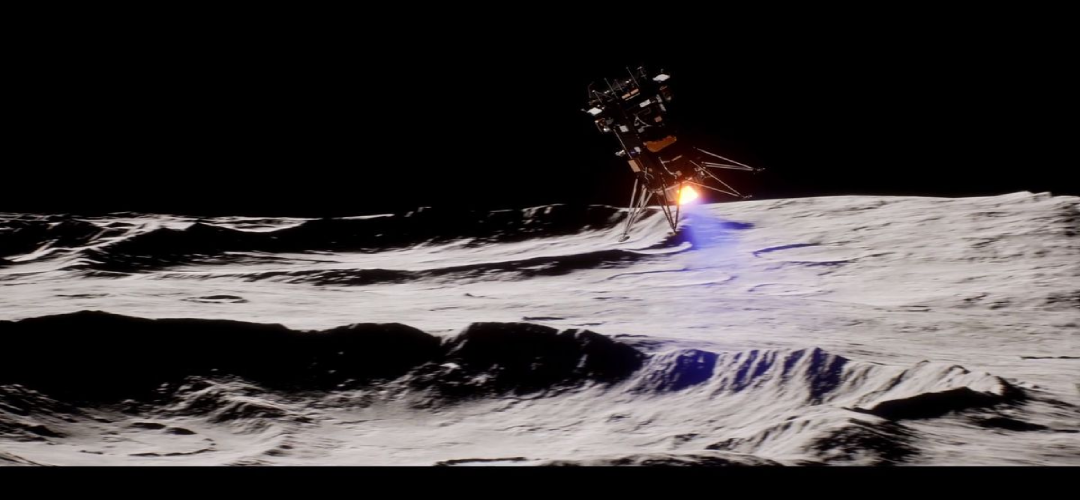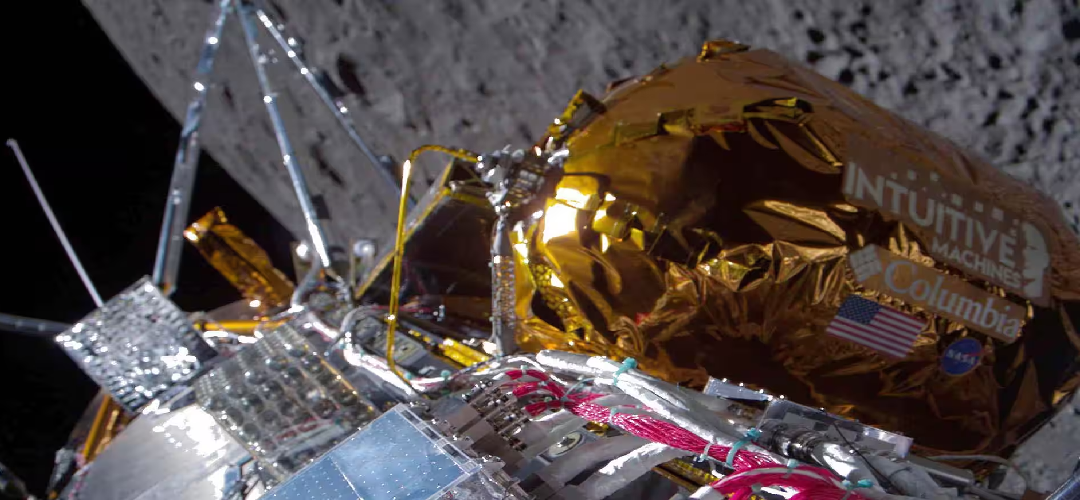Odysseus lands on Moon
March 3, 2024 | Expert Insights

On February 22nd, 2024, a historic moment unfolded in space exploration. The private spacecraft "Odysseus," built by Houston-based company Intuitive Machines, successfully touched down near the lunar south pole, marking the first time a private spacecraft achieved a soft landing on the moon. This accomplishment not only signifies a significant advancement in the realm of commercial space exploration but also reignites the global fascination with the moon and paves the way for further lunar exploration endeavours. Further, it marks a historic first on two fronts- it is the first soft landing of a private spacecraft on the Moon and the first American lunar lander since the Apollo 17 mission in 1972.
Background
The Odysseus mission, designated IM-1, pursued a two-pronged approach. Firstly, it aimed to validate the capabilities of the Nova-C lander, developed by Intuitive Machines, as a reliable platform for lunar operations. This entailed demonstrating the lander's proficiency in traversing the lunar environment, maneuvering during descent, and ultimately executing a soft touchdown on the lunar surface. Secondly, IM-1 served as a vital delivery vehicle for a diverse array of scientific instruments and technological demonstrations provided by NASA and other entities. These instruments were designed to gather crucial data and advance various areas of lunar exploration.
One instrument focused on analysing the interaction between a spacecraft's engine exhaust and the lunar regolith, the lunar equivalent of soil. Understanding these interactions is critical for future landing operations, as the exhaust plume can potentially disturb the surface and affect the stability of the spacecraft during touchdown. Another instrument explored the feasibility of utilizing lunar resources for future exploration endeavours. This research could pave the way for the development of in-situ resource utilization (ISRU) technologies, enabling future missions to extract and utilize resources such as water ice found on the Moon, potentially reducing dependence on Earth-supplied materials. Finally, a third instrument aimed to develop autonomous navigation systems, which could form the foundation for a comprehensive lunar navigation network. This network would enhance the precision and efficiency of future lunar missions by providing accurate positioning and guidance capabilities.
Furthermore, beyond its specific scientific and technological objectives, the IM-1 mission served as a crucial test bed for private companies participating in NASA's Commercial Lunar Payload Services (CLPS) program. CLPS aims to stimulate innovation and potentially decrease the overall cost of lunar access by incentivizing private companies to develop and operate lunar landers. The successful execution of IM-1 demonstrated the viability of private sector involvement in lunar exploration and holds significant promise for the future of this endeavour.

Analysis
The United States launched numerous missions to the Moon during the 1960s and early 1970s. These efforts were driven not solely by scientific curiosity, but also by a desire to demonstrate technological superiority over the Soviet Union, the nation's Cold War rival. This period culminated in the Apollo program, which successfully landed twelve astronauts on the lunar surface between 1969 and 1972. Following this decisive victory in the "Moon race," NASA shifted its focus to other human spaceflight endeavours, specifically the development and operation of the Space Shuttle program.
While numerous robotic probes, such as NASA's Lunar Reconnaissance Orbiter which has been circling the Moon since 2009, continued to be employed to study the lunar surface, a return to the surface itself was not a primary priority until recently. In December 2017, then-President Donald Trump directed NASA to return astronauts to the Moon within a relatively short timeframe. This directive resulted in the creation of the ambitious Artemis program, which aims to establish a long-term, sustainable human presence on and around the Moon by the end of the 2020s. Knowledge gained from Artemis will then be utilized to pave the way for astronaut missions to Mars in the late 2030s or early 2040s.
As part of Artemis, NASA intends to establish one or more bases in the Moon's south polar region, which is believed to contain significant water ice deposits. Before sending astronauts to this area, however, the agency desires to gather additional data about this relatively unexplored region. This data will be crucial in determining the extent of the water ice reserves and the feasibility of accessing this vital resource. The CLPS program facilitates the transportation of scientific instruments developed by the agency aboard robotic lunar landers constructed by American companies. "The primary objective of CLPS is to conduct lunar exploration in preparation for Artemis, while simultaneously implementing a novel approach to NASA's business model," stated Sue Lederer, CLPS project scientist at the Johnson Space Centre in Houston, during a press conference held on February 12th.
The successful landing of the Odysseus mission, a private endeavor by Intuitive Machines, has sent ripples across the space exploration landscape, opening doors for a future characterized by increased private involvement, a renewed focus on the lunar south pole, and potentially, greater international collaboration. This pivotal moment serves as a testament to the evolving landscape of space exploration, prompting important discussions surrounding resource utilization, debris mitigation, and the peaceful use of space.
The success of this mission demonstrates the viability and potential of private companies in propelling space exploration forward. This can lead to a more diverse and competitive space industry, fostering innovation and potentially lowering the cost of lunar access. As private companies take on a larger role, we can expect to see a wider range of lunar landers and spacecraft being developed and operated, leading to a more dynamic and multifaceted exploration landscape.
While the United States and China are currently at the forefront of lunar exploration, the complexity and scale of future endeavours might necessitate international collaboration. The success of the Odysseus mission, involving a private company and instruments from various entities, highlights the potential benefits of collaboration in achieving shared goals. As space exploration ventures further into the cosmos, fostering international cooperation on a larger scale will be crucial for tackling complex challenges, ensuring the peaceful use of space, and ultimately, expanding our collective understanding of the universe.
Assessment
- The expanding frontier of space exploration necessitates ethical considerations regarding resource utilization, debris mitigation, and the peaceful use of space. As we venture further into the cosmos, discussions on establishing clear frameworks and regulations that ensure responsible resource extraction, minimize the creation of space debris, and uphold the principles of peaceful exploration will become increasingly important.
- The success of the Odysseus mission serves as a timely reminder of the need for proactive discussions and collaborative efforts to ensure that space exploration continues to be a force for positive advancement and discovery.
- It demonstrates the growing capabilities of private companies, highlights the potential of the lunar south pole, and underscores the importance of international collaboration and responsible exploration practices.








Comments